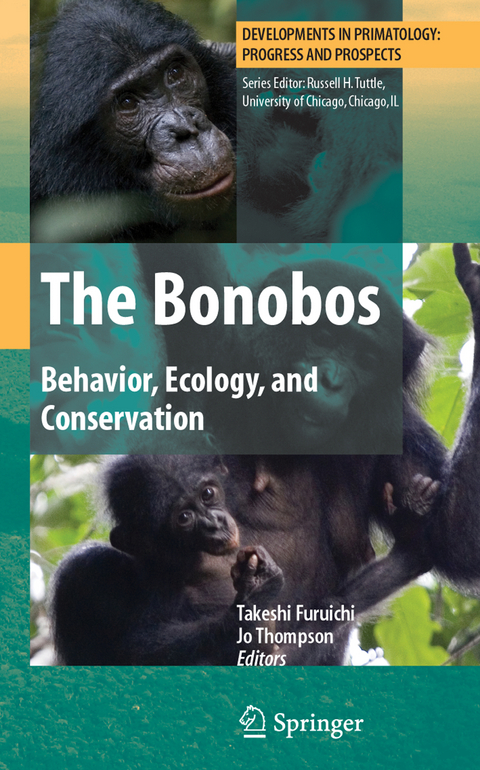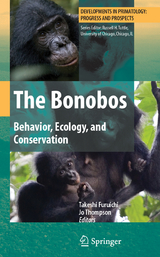The Bonobos
Springer-Verlag New York Inc.
978-0-387-74785-9 (ISBN)
Part One of The Bonobos: Behavior, Ecology, and Conservation focuses on scientific research. Behavioral studies in captivity propose to answer why bonobos have some unique characteristics such as high social status of females and flexible social relationships. The outcomes present important aspects to be investigated in running field studies. In the wild, analysis of population genetics across the bonobo's distribution range illuminates the species' evolutionary path and contributes to a global management plan. Site specific analysis reveals how genetics are used to re-identify individuals after an extended interruption of long-term research. Ecological studies at three independent sites, two in Salonga National Park, as well as one in the Luo Scientific Reserve, provide valuable information for the comprehension of ecological adaptation of bonobos. With the application of recent methods of mammalian feeding ecology as well as comparative approaches in other great ape species, these studies allow us to draw conclusions on ape ecological adaptation and evolution.
Part Two of The Bonobos: Behavior, Ecology, and Conservation focuses on conservation. In overview, local and global aspects of the factors threatening the wild bonobo population are reviewed. Here the outcomes of large-scale efforts within the functioning ecosystem conservation paradigm focus on three landscapes within the range of the bonobo: the Salonga-Lukenie-Sankuru Landscape, the Maringa-Lopori-Wamba Landscape, and the Lac Télé-Lac Tumba Swamp Forest Landscape, are presented. Papers in thispart include the different aspects of various stakeholders and discuss the unique threats and actions taken to ensure bonobo survival. Pioneering the way, details from the first comprehensive assessment of bonobos in the Salonga National Park reveal a baseline from which to monitor future trends. Concerned about the indigenous' peoples aspects of conservation, an ethnographic study documents cultural, social, and economic practices for the purpose of reviving the local traditional knowledge to exemplify possible applications at the national level. To be inclusive of all aspects of range country concerns, the contributions of Kinshasa's bonobo sanctuary to national conservation efforts are presented. The outcome of these contributions taken together not only illuminate the current status of the bonobo but allow for critically designing the next steps for the continuation of its future.
Behavioral Study Section.- The Bonobo’s Adaptive Potential: Social Relations under Captive Conditions.- What Does Agonistic Dominance Imply in Bonobos?.- Social Play in Bonobos: Not Only an Immature Matter.- Gestures and Multimodal Signaling in Bonobos.- Ecological Study Section.- Longitudinal Structure of a Unit-group of Bonobos: Male Philopatry and Possible Fusion of Unit-groups.- Seasonal Changes in Fruit Production and Party Size of Bonobos at Wamba.- Relationships among Fruit Abundance, Ranging Rate, and Party Size and Composition of Bonobos at Wamba.- Bonobo (Pan paniscus) Density Estimation in the SW-Salonga National Park, Democratic Republic of Congo: Common Methodology Revisited.- Ecological Factors Influencing Bonobo Density and Distribution in the Salonga National Park: Applications for Population Assessment.- Range Occupation and Population Estimates of Bonobos in the Salonga National Park: Application to Large-scale Surveys of Bonobos in the Democratic Republic of Congo.- Conservation Study Section.- Traditional Land-use Practices for Bonobo Conservation.- Human Hunting and its Impact on Bonobos in the Salonga National Park, Democratic Republic of Congo.- The Bonobos of the Lake Tumba – Lake Maindombe Hinterland: Threats and Opportunities for Population Conservation.- Changes in the Status of Bonobos, their Habitat, and the Situation of Humans at Wamba in the Luo Scientific Reserve, Democratic Republic of Congo.- The Conservation Value of Lola ya Bonobo Sanctuary.
| Reihe/Serie | Developments in Primatology: Progress and Prospects |
|---|---|
| Zusatzinfo | XIII, 327 p. |
| Verlagsort | New York, NY |
| Sprache | englisch |
| Maße | 155 x 235 mm |
| Themenwelt | Sachbuch/Ratgeber ► Natur / Technik ► Natur / Ökologie |
| Naturwissenschaften ► Biologie ► Genetik / Molekularbiologie | |
| Naturwissenschaften ► Biologie ► Ökologie / Naturschutz | |
| Naturwissenschaften ► Biologie ► Zoologie | |
| ISBN-10 | 0-387-74785-0 / 0387747850 |
| ISBN-13 | 978-0-387-74785-9 / 9780387747859 |
| Zustand | Neuware |
| Haben Sie eine Frage zum Produkt? |
aus dem Bereich




